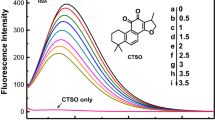Abstract
Resveratrol is a natural phytoalexin with pharmacologic effects on several human diseases: carcinogenesis, coronary heart disease and neurodegenerative disease. Due to its poor water solubility, resveratrol must be bound to proteins to keep it at a high concentration in serum. In our work, the bindings of resveratrol to plasma proteins, human serum albumin (HSA) and hemoglobin (Hb), have been investigated systematically by fluorescence quenching technique, synchronous fluorescence, UV–vis absorption spectroscopy, circular dichroism (CD) spectroscopy and molecular modeling method. The fluorescence data show that the binding of resveratrol to HSA or Hb is a static quenching procedure and each protein has only one binding site for the drug. The binding constant of resveratrol to HSA is larger than that of resveratrol to Hb at corresponding temperature, which indicates that the affinity of HSA toward the drug is higher than that of Hb. The CD spectroscopy indicates that the secondary structures of the proteins are changed in the presence of resveratrol with the reduction of α-helices, which decreased about 18.75% for HSA and 9.43% for Hb at the drug to proteins molar ratio of 2. Thermodynamic analysis and molecular modeling suggest that hydrophobic interaction plays a major role in the binding of resveratrol to HSA, and hydrogen bonding is the mainly binding force in the binding of resveratrol to Hb. The study of molecular modeling shows that resveratrol is located in the hydrophobic cavity between subdomain IB and IIA of HSA (the entrance of site I), or located in the central cavity of Hb (partial to the subunit A).







Similar content being viewed by others
References
Fremont L (2000) Biological effects of resveratrol. Life Sci 66:663–673
de la Lastra CA, Villegas L (2005) Resveratrol as an anti-inflammatory and anti-aging agent: mechanism and clinical implications. Mol Nutr Food Res 49:405–430
Nanji AA, French SW (1986) Alcoholic beverages and coronary heart disease. Atherosclerosis 60:197–198
Goldberg DM, Hahn SE, Parkes JG (1995) Beyond alcohol—beverage consumption and cardiovascular mortality. Clin Chim Acta 237:155–187
Fremont L, Belguendouz L, Delpal S (1999) Antioxidant activity of resveratrol and alcohol-free wine polyphenols related to LDL oxidation and polyunsaturated fatty acids. Life Sci 64:2511–2521
Paula B, Leonor MA, Teresa CPD (2002) The interaction of resveratrol with ferrylmyoglobin and peroxynitrite; protection against LDL oxidation. Free Radic Biol Med 36(6):621–631
Pace-Asciak CR, Hahn S, Diamandis EP, Soleas G, Goldberg DM (1995) The red wine phenolics trans-resveratrol and quercetin block human platelet aggregation and eicosanoids synthesis: implications for protection against coronary heart disease. Clin Chim Acta 235:207–219
Jang M, Cai L, Udeani GO, Slowing KV, Thomas CF, BeecherH. CW, Fong H, Farnsworth NR, Kinghorn AD, Mehta RG, Moon RC, Pezzuto JM (1997) Cancer chemopreventive activity of resveratrol, a natural product derived from grapes. Science 275:218–220
Belguendouz L, Linard A (1997) Resveratrol inhibits metal ion dependent and independent peroxidation of porcine low-density lipoproteins. Biochem Pharmacol 53:1347–1355
Khan MA, Muzammil S, Musarrat J (2002) Differential binding of tetracyclines with serum albumin and induced structural alterations in drug-bound protein. Int J Bio Macromol 30:243–249
Jannin B, Menzel M, Berlot JP, Delmas D, Lancon A, Latruffe N (2004) Transport of resveratrol, a cancer chemopreventive agent, to cellular targets: plasmatic protein binding and cell uptake. Biochem Pharmacol 68:1113–1118
Lancon A, Delmas D, Osman H, Thénot JP, Jannin B, Latruffe N (2004) Human hepatic cell uptake of resveratrol: involvement of both passive diffusion and carrier-mediated process. Biochem Biophys Res Commun 316:1132–1137
Fiorani M, Accorsi A, Cantoni O (2003) Human red blood cells as a natural flavonoid reservoir. Free Radical Res 37:1331–1338
Morris GM, Goodsell DS, Halliday RS, Huey R, Hart WE, Belew RK, Olson AJ (1998) Automated docking using Lamarckian genetic algorithm and an empirical binding free energy function. J Comp Chem 19:1639–1662
Sanner MF, Duncan BS, Carrillo CJ, Olson AJ (1998) Integrating computation and visualization for biomolecular analysis: an example using Python and AVS. Proc Pac Symp Biocomput 99:401–412
Li Y, He WY, Xue, CX, Hu ZD, Chen XG, Sheng FL (2005) Effect of Chinese medicine alpinetin on the structure of human serum albumin. Bioorg Med Chem 13:1837–1845
Kandagal PB, Ashoka S, Seetharamappa J, Shaikh SMT, Jadegoud Y, Ijare OB (2006) Study of the interaction of an anticancer drug with human and bovine serum albumin: spectroscopic approach. J Pharm Biomed 41:393–399
Vaughan WM, Weber G (1970) Oxygen quenching of pyrenebutyric acid fluorescence in water: a dynamic probe of the microenvironment. Biochemistry 9:464–473
Peeters H (1972) Proteins of Biological Fluids. Pergamon, Oxford
Ross PD, Subramanian S (1981) Thermodynamics of protein association reactions: forces contributing to stability. Biochemistry 20:3096–3102
Tang JH, Luan F, Chen XG (2006) Binding analysis of glycyrrhetinic acid to human serum albumin: Fluorescence spectroscopy, FTIR, and molecular modeling. Bioorg Med Chem 14:3210–3217
Mahal HS, Mukherjee T (2006) Scavenging of reactive oxygen radicals by resveratrol: antioxidant effect. Res Chem Intermed 32:59–71
Yuan T, Weljie AM, Vogel HJ (1998) Tryptophan fluorescence quenching by methionine and selenomethione residues of calmodulin: orientation of peptide and protein binding. Biochemistry 37:3187–3195
Rahman MH, Maruyama T, Okaka T, Yamasaki K, Otagiri M (1993) Study of interaction of carprofen and its enantiomers with human serum albumin—I. Mechanism of binding studied by dialysis and spectroscopic methods. Biochem Pharmacol 46:1721–1731
Acknowledgements
This work is supported by grants from National Fund of Nature Science of China (No.30670464) and The Research Fund for the Doctoral program of Higher Education of China.
Author information
Authors and Affiliations
Corresponding author
Rights and permissions
About this article
Cite this article
Lu, Z., Zhang, Y., Liu, H. et al. Transport of a Cancer Chemopreventive Polyphenol, Resveratrol: Interaction with Serum Albumin and Hemoglobin. J Fluoresc 17, 580–587 (2007). https://doi.org/10.1007/s10895-007-0220-2
Received:
Accepted:
Published:
Issue Date:
DOI: https://doi.org/10.1007/s10895-007-0220-2




